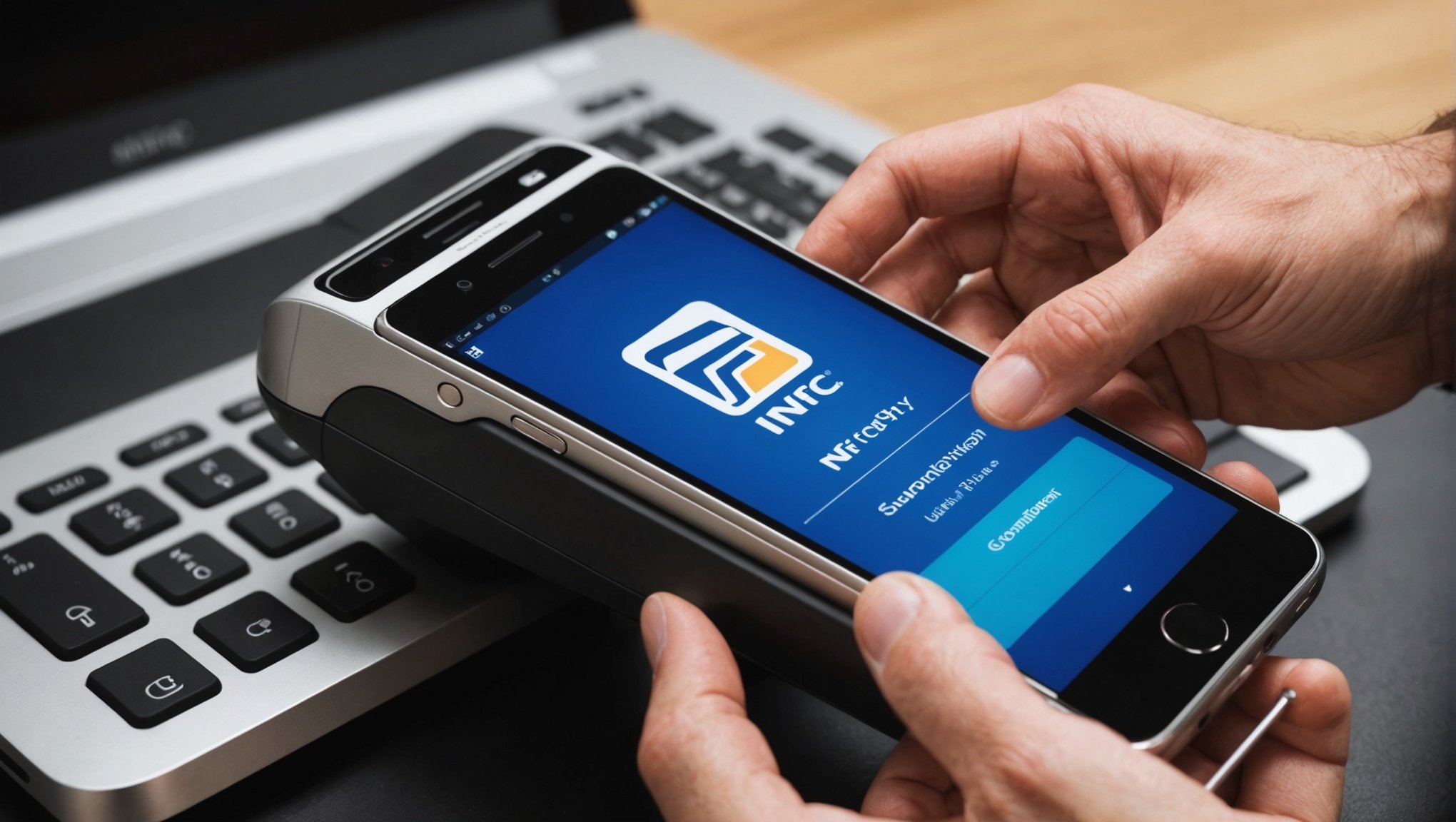In an age where technology constantly evolves, contactless payments have become not just a convenience but a necessity. Near Field Communication (NFC) is at the forefront of these advancements, revolutionizing how we conduct transactions. This article aims to unravel the intricacies of NFC technology, especially in the context of mobile payments. We will guide you through the nuts and bolts of how to use NFC-enabled smartphones for secure and seamless payments, ensuring you’re well-equipped to leverage this cutting-edge technology.
What is NFC Technology?
NFC, or Near Field Communication, is a form of wireless communication that allows data to be exchanged between devices over a short distance, typically a few centimeters. Unlike Bluetooth or Wi-Fi, NFC operates at a much closer range, making it uniquely suited for secure transactions. This proximity feature ensures data is only exchanged between intended devices, thereby enhancing security.
Topic to read : How to Use Your Smartphone to Program and Control Robots?
NFC technology is predominantly used in payment cards, smartphones, and other mobile devices. When you tap your device on an NFC-enabled payment terminal, the embedded NFC chip communicates with the terminal to process the payment. This interaction is swift, taking just a few seconds, thus offering a quick and efficient payment method.
With NFC, not only can you make payments, but you can also share data between devices, use it for identification purposes, and even access public transport. The technology is versatile, making it a cornerstone in the future of digital transactions.
Also read : How to Use Your Smartphone for Managing Smart Agriculture Systems?
How NFC Payments Work
NFC payments are a subset of contactless payments, providing a hassle-free method to pay for goods and services. To use NFC for payments, you need an NFC-enabled device and a compatible payment card or mobile wallet app.
First, let’s delve into the process:
- Activation: Ensure your smartphone’s NFC feature is enabled. This setting is often found in the ‘Connections’ or ‘Network’ settings of the device.
- Digital Wallet Setup: Download a digital wallet app like Google Pay, Apple Pay, or Samsung Pay. Link your payment cards by following the app’s instructions, which typically involve entering card details and verifying through an SMS or email.
- Payment: When at a point of sale, simply unlock your phone and tap it on the NFC-enabled terminal. The transaction is processed almost instantaneously.
NFC’s security mechanisms like tokenization and encryption play a crucial role in safeguarding your transaction. When you tap your device, a unique token replaces your card details, ensuring sensitive information is not transmitted. This adds a robust layer of security, making NFC payments one of the most secure methods available today.
Security Measures in NFC Payments
Security is paramount when it comes to financial transactions, and NFC technology excels in this area. Here’s how:
Tokenization
When an NFC transaction is initiated, your actual card details are replaced with a unique token. This token is only valid for that specific transaction, minimizing the risk of fraud.
Encryption
NFC uses advanced encryption standards to ensure that data transferred between devices is secure. This encryption makes it extremely difficult for unauthorized entities to intercept and decode the information.
Limited Range
The short-range operation of NFC adds another security layer. Since NFC works within a span of a few centimeters, it is less susceptible to remote interception.
Biometric Authentication
Modern smartphones offer additional layers of security through biometric authentication methods like fingerprint scanning or facial recognition. These features add a personal verification step, ensuring that only the authorized user can initiate a payment.
Regular Monitoring
Many digital wallet apps provide real-time notifications for each transaction. This allows you to monitor your account activity closely and quickly spot any unauthorized transactions.
While NFC technology is inherently secure, you must also adopt best practices. Regularly update your phone’s software, use strong passwords, and be vigilant about the apps you download. These steps will further protect your financial information and ensure a secure payment experience.
Advantages of NFC Payments
The advantages of using NFC technology for payments extend beyond just security. Here are some compelling reasons why you should consider making the switch:
Speed and Convenience
NFC payments are incredibly fast. A simple tap on the terminal completes the transaction in seconds, significantly reducing wait times. This speed is beneficial for both customers and merchants, making the shopping experience more pleasant.
Enhanced User Experience
With NFC, you no longer need to carry multiple cards in your wallet. All your payment methods can be stored securely on your smartphone. This not only declutters your physical wallet but also makes it easier to manage your finances.
Versatility
NFC is not limited to payments alone. You can use it for a variety of functions such as accessing public transport, sharing files, and even for identification purposes. This versatility makes NFC a multipurpose technology that adds value to various aspects of daily life.
Environmentally Friendly
Going digital with NFC payments reduces the need for plastic cards and paper receipts. This shift is a small yet significant step towards a more sustainable future.
Contactless Interaction
In the wake of global health concerns, contactless payments have gained prominence. NFC’s capability to facilitate payments without any physical contact aligns perfectly with the need for hygienic transaction methods.
By leveraging these advantages, you can make your life simpler and more efficient. NFC technology not only streamlines the payment process but also adds multiple layers of convenience and utility.
Getting Started with NFC Payments
Now that you understand the intricacies and advantages of NFC payments, let’s look at how you can get started.
Step-by-step Guide:
- Check Compatibility: Ensure your smartphone is NFC-enabled. Most modern smartphones come with this feature, but it’s good to double-check.
- Enable NFC: Go to your phone’s settings, navigate to ‘Connections’ or ‘Network & Internet,’ and enable NFC.
- Choose a Digital Wallet: Download a digital wallet app. Popular choices include Google Pay, Apple Pay, and Samsung Pay.
- Add Payment Methods: Follow the app’s instructions to add your payment cards. This usually involves entering card details and completing a verification process.
- Set Up Biometric Authentication: For added security, enable fingerprint or facial recognition through your phone’s settings.
- Make a Payment: When at a store, unlock your phone, open the digital wallet app, and tap your phone on the NFC-enabled payment terminal. Confirm the transaction if prompted.
By following these steps, you will be well on your way to making secure NFC payments. The digital wallet app will typically guide you through the process, making it user-friendly and straightforward.
NFC technology has revolutionized the way we perform transactions, offering a fast, secure, and convenient payment method. By leveraging NFC-enabled mobile devices, you can make payments with a simple tap, enjoying a host of benefits from speed to heightened security. The robust security measures, including tokenization and encryption, ensure that your financial information remains safe.
Adopting NFC payments involves a few simple steps, from checking your device’s compatibility to setting up a digital wallet and adding your payment cards. With these steps in place, you can enjoy the manifold advantages of NFC payments, from reduced wait times to a cleaner, more sustainable transaction method.
In summary, NFC technology is not just a passing trend; it’s a significant leap towards a seamless and secure future in digital payments. As more merchants and customers embrace this technology, the convenience and security of NFC payments will undoubtedly become an integral part of our everyday lives. So, if you haven’t already, now is the time to explore and adopt NFC technology for your payment needs.











